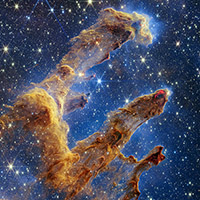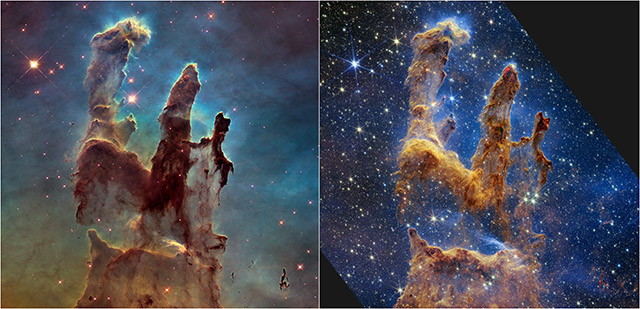Webb captures exceptionally detailed, star-filled portrait of the Pillars of Creation, revisiting one of Hubble’s most famous subjects
posted Wednesday, October 19, 2022 at 2:00 PM EDT

NASA's James Webb Space Telescope has captured a stunning, high-resolution image of the iconic Pillars of Creation. The incredible image shows a stellar nursery, where new stars are forming among the dense clouds of gas and dust. The Pillars of Creation is a small portion of the Eagle Nebula, a cluster of stars about 6,500 to 7,000 light-years from Earth.
In the image below, the three-dimensional pillars are comprised of "cool interstellar gas and dust" that can appear semi-transparent when viewed in near-infrared light. Webb's Near-Infrared Camera (NIRCam) shows many newly formed stars, which appear as bright red orbs in the image below. NASA writes, "When knots with sufficient mass form within the pillars of gas and dust, they begin to collapse under their own gravity, slowly heat up, and eventually form new stars."

Credits: NASA, ESA, CSA, STScI; Joseph DePasquale (STScI), Anton M. Koekemoer (STScI), Alyssa Pagan (STScI).
Click here to download the full-resolution version.
The wavy lines that "look like lava at the edges of some pillars" are ejections from stars still forming within the gas and dust. Young stars occasionally expel supersonic jets. These jets collide with clouds of material, like the pillars, which can result in shocks that create wavy patterns, much like a boat creates as it moves through water. The crimson glow, which you can see especially well at the top of the middle and rightmost pillars, results from energetic hydrogen molecules from jets and shocks. The young stars causing these jets are likely only a few hundred thousand years old – practically infants in the scale of the universe.
Although it seems like Webb's NIRCam has afforded us the ability to see through the gas and dust, the situation is more complex. The mix of translucent gas and dust, known as the interstellar medium, blocks our view of the deeper universe, meaning that we can't see galaxies in this view. The pillars are located directly in front of the Milky Way galaxy's disc, which blocks our view of any galaxies behind it. While Hubble was limited more by the dusty pillars, Webb's view of the deeper universe is held back by the interstellar medium.
However, thanks to Webb's excellent resolving power and sophisticated imaging equipment, we can see the Pillars of Creation much better than we could with Hubble. The Hubble Space Telescope first imaged the scene in 1995 and again in 2014. You can see how much better Webb's view is in the comparison below.

Credits: NASA, ESA, CSA, STScI; Joseph DePasquale (STScI), Anton M. Koekemoer (STScI), Alyssa Pagan (STScI).
Click here to download the full-resolution version.
The Space Telescope Science Institute writes, "The background of this Hubble image is like a sunrise, beginning in yellows at the bottom, before transitioning to light green and deeper blues at the top. These colors highlight the thickness of the dust all around the pillars, which obscures many more stars in the overall region." In Webb's image, the background light appears in blue hues, showing the hydrogen atoms better. By offering a better view of the dusty pillars, Webb's image helps scientists identify stars that just burst free or are about to. Near-infrared light offers much more information.